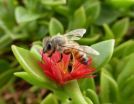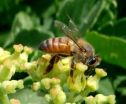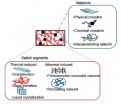East African honeybees are safe from invasive pests… for now
2014-04-17
(Press-News.org) Several parasites and pathogens that devastate honeybees in Europe, Asia and the United States are spreading across East Africa, but do not appear to be impacting native honeybee populations at this time, according to an international team of researchers.
The invasive pests include including Nosema microsporidia and Varroa mites.
"Our East African honeybees appear to be resilient to these invasive pests, which suggests to us that the chemicals used to control pests in Europe, Asia and the United States currently are not necessary in East Africa," said Elliud Muli, senior lecturer in the Department of Biological Sciences, South Eastern Kenya University, and researcher at the International Centre of Insect Physiology and Ecology, Kenya.
The team first discovered Varroa mites in Kenya in 2009. This new study also provides baseline data for future analyses of possible threats to African honeybee populations.
"Kenyan beekeepers believe that bee populations have been experiencing declines in recent years, but our results suggest that the common causes for colony losses in the United States and Europe -- parasites, pathogens and pesticides -- do not seem to be affecting Kenyan bees, at least not yet," said Christina Grozinger, professor of entomology and director of the Center for Pollinator Research, Penn State. "Some of our preliminary data suggest that the loss of habitat and drought impacting flowering plants, from which the bees get all their food, may be the more important factor driving these declines."
According to Harland Patch, research scientist in entomology, Penn State, not only are flowering plants important for honeybees, but the insects are important for plants as well.
"Honeybees are pollinators of untold numbers of plants in every ecosystem on the African continent," Patch said. "They pollinate many food crops as well as those important for economic development, and their products, like honey and wax, are vital to the livelihood of many families. People say the greatest animal in Africa is the lion or the elephant, but honeybees are more essential, and their decline would have profound impacts across the continent."
In 2010, the researchers conducted a nationwide survey of 24 locations across Kenya to evaluate the numbers and sizes of honeybee colonies, assess the presence or absence of Varroa and Nosema parasites and viruses, identify and measure pesticide contaminants in hives and determine the genetic composition of the colonies.
"This is the first comprehensive survey of bee health in East Africa, where we have examined diseases, genetics and the environment to better understand what factors are most important in bee health in this region," said Grozinger. The results appeared today in PLOS ONE.
The researchers found that Varroa mites were present throughout Kenya, except in the remote north. In addition, Varroa numbers increased with elevation, suggesting that environmental factors may play a role in honeybee host-parasite interactions. Most importantly, the team found that while Varroa infestation dramatically reduces honeybee colony survival in the United States and Europe, in Kenya, its presence alone does not appear to impact colony size.
The scientists found Nosema at three sites along the coast and one interior site. At all of the sites, they found only a small number of pesticides at low concentrations. Of the seven common honeybee viruses in the United States and Europe, the team only identified three species, but, like Varroa, these species were absent from northern Kenya. The number of viruses present was positively correlated with Varroa levels, but was not related to colony size.
"The Africanized bees -- the so-called 'killer bees' -- in the Americas seem to be having no problem with Varroa or diseases, so I would not be surprised to find they have some innate genetic tolerance to these pests," Patch said. "We suspect the seemingly greater tolerance of African bees to these pests over the western bees is a combination of genes and environment."
Given their findings that African honeybees currently appear to be resilient to the effects of parasites and viruses, the researchers recommend that beekeepers in East Africa maintain healthy bee populations by protecting vital nesting habitat and the native flowering plant diversity that the bees depend on for food. In addition, the researchers suggest that beekeepers use pesticides sparingly.
"This research is important because it confirms the resilience of African bees despite the heavy presence of recently introduced Varroa mites, and it suggests that the approach to manage these pests should not follow the application of pesticides as has been done in the western world," said Muli.
These newly introduced pests to Africa might have long-term implications for the honeybee populations.
"As these new parasites and pathogens become more widespread, as pesticide use increases and as landscape degradation increases due to increased urbanization, farming and climate change, we expect to see the combination of all these factors negatively impact the bees in the future," Grozinger said.
INFORMATION:
Other authors on the paper include Maryann Frazier, senior extension associate; James Frazier, professor of entomology; Tracey Baumgarten, research technologist, and James Tumlinson, Ralph O. Mumma Endowed Professor in Entomology, all at Penn State. Authors also include Baldwyn Torto, principal scientist and head of he Department of Behavioural and Chemical Ecology; Joseph Kilonzo, research technician; James Kimani, research technician; Fiona Mumoki, research assistant; Daniel Masiga, senior scientist and head of the Molecular Biology Unit all at the International Centre of Insect Physiology and Ecology.
This research was supported initially by a USDA grant, which resulted in the discovery of Varroa mites in Kenya in 2009, and subsequently was supported by a Basic Research to Enable Agricultural Development (BREAD) grant from the U.S. National Science Foundation.
ELSE PRESS RELEASES FROM THIS DATE:
Drought and fire in the Amazon lead to sharp increases in forest tree mortality
2014-04-17
Ongoing deforestation and fragmentation of forests in the Amazon help create tinderbox conditions for wildfires in remnant forests, contributing to rapid and widespread forest loss during drought years, according to a team of researchers.
The findings show that forests in the Amazon could reach a "tipping point" when severe droughts coupled with forest fires lead to large-scale loss of trees, making recovery more difficult, said Jennifer Balch, assistant professor of geography, Penn State.
"We documented one of the highest tree mortality rates witnessed in Amazon forests," ...
Classifying cognitive styles across disciplines
2014-04-17
Educators have tried to boost learning by focusing on differences in learning styles. Management consultants tout the impact that different decision-making styles have on productivity. Various fields have developed diverse approaches to understanding the way people process information. A new report from psychological scientists aims to integrate these disciplines by offering a new, integrated framework of cognitive styles that bridges different terminologies, concepts, and approaches.
"This new taxonomy of cognitive styles offers a clear categorization of different types ...
Unraveling the 'black ribbon' around lung cancer
2014-04-17
It's not uncommon these days to find a colored ribbon representing a disease. A pink ribbon is well known to signify breast cancer. But what color ribbon does one think of with lung cancer?
Although white has been identified as the designated color, for many suffering from the disease, black may be the only one they think fits.
A Michigan State University study consisting of lung cancer patients, primarily smokers between the ages of 51 to 79 years old, is shedding more light on the stigma often felt by these patients, the emotional toll it can have and how health providers ...
Some immune cells defend only 1 organ
2014-04-17
Scientists have uncovered a new way the immune system may fight cancers and viral infections. The finding could aid efforts to use immune cells to treat illness.
The research, in mice, suggests that some organs have the immunological equivalent of "neighborhood police" – specialized squads of defenders that patrol only one area, a single organ, instead of an entire city, the body.
Scientists at Washington University School of Medicine in St. Louis have shown that the liver, skin and uterus each has dedicated immune cells, which they call tissue-resident natural killer ...
Deaths from viral hepatitis surpasses HIV/AIDS as preventable cause of deaths in Australia
2014-04-17
The analysis was conducted by Dr Benjamin Cowie and Ms Jennifer MacLachlan from the University of Melbourne and Melbourne Health, and was presented at The International Liver Congress in London earlier this month.
"Liver cancer is the fastest increasing cause of cancer deaths in Australia, increasing each year by 5 per cent, so by more than seventy people each year. In 2014 there was an estimated number of deaths of around 1,500 from liver cancer. The predominant cause is chronic viral Hepatitis," Dr Cowie said.
Hepatitis refers to the inflammation of the liver. Chronic ...
Ancient sea-levels give new clues on ice ages
2014-04-17
International researchers, led by the Australian National University (ANU), have developed a new way to determine sea-level changes and deep-sea temperature variability over the past 5.3 million years.
The findings will help scientists better understand the climate surrounding ice ages over the past two million years, and could help determine the relationship between carbon dioxide levels, global temperatures and sea levels.
The team from ANU, the University of Southampton (UoS) and the National Oceanography Centre (NOC) in the United Kingdom, examined oxygen isotope ...
Scientists find new way to fight malaria drug resistance
2014-04-17
An anti-malarial treatment that lost its status as the leading weapon against the deadly disease could be given a new lease of life, with new research indicating it simply needs to be administered differently.
The findings could revive the use of the cheap anti-malarial drug chloroquine in treating and preventing the mosquito-bourne disease, which claims the lives of more than half a million people each year around the world.
The parasite that causes malaria has developed resistance to chloroquine, but research carried out at the Australian National University (ANU) ...
Newlyweds, be careful what you wish for
2014-04-17
A statistical analysis of the gift "fulfillments" at several hundred online wedding gift registries suggests that wedding guests are caught between a rock and a hard place when it comes to buying an appropriate gift for the happy couple. The details reported in the International Journal of Electronic Marketing and Retailing suggest that most people hope to garner social benefits of buying an expensive gift that somehow enhances their relationship with the newlyweds while at the same time they wish to limit monetary cost and save money.
Yun Kyung Oh of the Department of ...
More research called for into HIV and schistosomiasis coinfection in African children
2014-04-17
Researchers from LSTM have called for more research to be carried out into HIV and schistosomiasis coinfection in children in sub-Saharan Africa. In a paper in The Lancet Infectious Diseases LSTM's Professor Russell Stothard, working with colleagues in the department of Parasitology and researchers from Cape Western Reserve University, in Cleveland Ohio, University of Cambridge and the Royal Veterinary College looked at previous research into the joint burden of HIV/AIDS and schistosomiasis of children, and found that while disease-specific control interventions are continuing, ...
Biomedical applications of shape-memory polymers: How practically useful are they?
2014-04-17
Polymers that exhibit shape-memory effect (SME) are an important class of materials in medicine, especially for minimally invasive deployment of devices. Professor Subbu Venkatraman and his group from School of Materials Science and Engineering, Nanyang Technological University presented a review article surveying the clinical applications of the SME and addressing critically the question of its utility in implantable devices. Their work, entitled "Biomedical applications of shape-memory polymers: How practically useful are they?", was published in SCIENCE CHINA Chemistry.2014, ...





